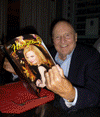In the last issue we spoke to Billy Name about his memories of Edie Sedgwick, to coincide with the release of the mainstream Hollywood flick Factory Girl. Over the past several years that I have gotten to know and interview the 67-year-old photographer, Billy has remained the most important living resource for the dish on Warhol, the Factory, fleeting superstar fame, and that drug-dappled decade of the sixties.
The silver sixties, which describes a decade of profound cultural transformation, is a term inspired by the New York pop art scene, in particular that scene embodied by Andy Warhol's studio at 231 East 47th Street, which would become known as the Factory. With the help of avant-garde theater lighting designer Billy Linich, Warhol's loft space was transformed into the Silver Factory, which went on to define an era. Andy met him in 1959 when Billy was a waiter at his favorite Upper East Side restaurant, Serendipity 3.
"He wasn't the famous Andy Warhol then," says Name. "So I knew Andy from before his fame. I knew him longer than anybody else, I guess."
They met socially through their mutual friend, the artist Ray John-son, who brought Andy to one of Billy's "haircut parties," which helped pay the rent of his East Village apartment. Name had his place painted and wrapped in silver, and Warhol dug it. He asked him to do the same to his studio. This sort of "installation" was inspired by a bridge where Billy grew up in Poughkeepsie.
"Every seven years they re-painted it with this heavy-duty industrial aluminum paint. That's where I must have gotten the inspiration from, because I always thought that was sort of a magic thing to do, paint a whole big thing all one color, silver. It's electric. It's synthetic, it's fusion. It's out of the ordinary, and it's tense and it's hip and it's cool and it's spacey."
Billy adopted the last name Name, and, from 1963 to the end of the decade, served as Andy's photographer and the Factory manager. He left the Factory in 1970 after tacking a note to Andy on the darkroom door.
I met Billy several years ago at an art opening at the Gershwin Hotel, that cheap-chic boutique hotel on E. 27th, where each floor is decorated by a different artist. On the wall between the elevators is a glass case containing a Campbell's soup can signed by Warhol, who is the hotel's spiritual inspiration. Billy has his own floor whose walls are covered with his sixties photos, and the hotel recently held Factory Craze: A Week of Andy Warhol, a celebration of the artist on the 20th anniversary of his death that attracted Factory-era "superstars" including Name, Lou Reed, Ivy Nicholson, Bibbe Hansen, Ultra Violet, Penny Arcade, Taylor Mead, Mary Woronov, Holly Woodlawn, Ronnie Cutrone, and Allen Midgette. Billy has published two amazing books of his photos, Billy Name: Stills From the Warhol Films and All Tomorrow's Parties: Billy Name's Photographs of Andy Warhol's Factory.
When I got past my initial impression of Billy as a friendly longhaired graying hippie with art-world pretensions and realized who he was-a chronicler of and witness to the most famous era of underground American art and culture-I discovered an entire hip universe that had only been hinted at in my college art-history class. Talking to Billy about the sixties is like talking to Carl Sagan about space travel. The man's got stories to tell, and more than once I got him to chew my ear with them. He is articulate and easily quotable.
I have always been a big Velvet Underground and Lou Reed fan-there's something about the seamy drug-and-sex underbelly addressed in their music-so a lot of my questions have had to do with Lou and the Factory drug scene. Reed's famous for shooting all sorts of drugs (evidenced by the Velvets' "Heroin" and the methamphetamine anthems "White Light/White Heat" and "Sister Ray"), and I wondered if Billy was into that scene, and what drugs were popular around the Factory and how they affected the work being done there.
"I was doing a lot of LSD and methamphetamine at the time," he told me. "I never really shot up because I hate needles, and so I always shied away from that aspect of it. But I really just would mix it in something and drink it. And Andy had what you call a diet pill from a doctor, Obetrol, a mellow form of amphetamine. It's not like rough and intense like methamphetamine hydrochloride, the black-market stuff that you get from a dealer. It's mellower but still it activates your nervous system."
It was a naive time. But the drugs were merely incidental to that decade. The thing that mattered most was the art and, of course, being famous.
"Basically we used these things for fuel; we were high-octane people. We needed a higher-octane fuel than just coffee or booze, because we really loved the work we did and we all loved working. And it was such a fantastic time; we knew where we were, in the center of the art world and at the pinnacle of it, and the power of the experience was just amazingly wonderful. And so we all really knew it was our time to work."




